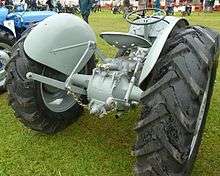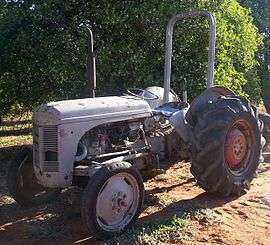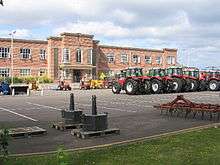Ferguson TE20
| Ferguson TE20 | |
|---|---|
|
1955 Ferguson TEF | |
| Type | Agricultural tractor |
| Manufacturer | Ferguson Company |
| Production | 1946–1956 |
The Ferguson TE20 is an agricultural tractor designed by Harry Ferguson. By far his most successful design, it was manufactured from 1946 until 1956, and was commonly known as the Little Grey Fergie. It is light-weight but effective, and a popular collector's item for enthusiasts today.
History

The model name came from Tractor, England 20 horsepower[1] (not the true power delivered but from a formula based on engine size).
The TE range of Ferguson tractors was introduced in England in 1946,[2] following 30 years of continuous development of 'The Ferguson System' from 1916. The first work was to design a plough and linkage to integrate the tractor with its work in a manner that was an engineering whole. The automatic control system is now employed by almost all tractor manufacturers worldwide. A British patent was applied for by Harry Ferguson in 1925 and granted the following year.
By the early 1930s the linkage design was finalised and is now adopted as international standard category I. Just one prototype Ferguson System tractor, known as the Ferguson Black, was built to further technical development and for demonstrating to potential manufacturers. During 1936 the first production Ferguson tractors were built in Huddersfield, Yorkshire, by the David Brown Company. This tractor, the Ferguson Model 'A', incorporated Harry Ferguson's 'suction side' hydraulic control system, the key to solving sensitive automatic control of three point mounted implements and patented on 5 February 1936 (patent no 470069). The combination of Ferguson's converging three point hitch, patented on 3 July 1928 (patent no 320084) with his 'suction side control' valve is the key to the success of all subsequent Ferguson and later Massey Ferguson 'Ferguson System' tractors, the most important of which are the TE and TO 20 models. (It was the production of the Model 'A' that led in 1939 to the David Brown line of tractors).[3]
In order to get volume production with lower costs, following a demonstration of his tractor before Henry Ford Senior in October 1938, Ferguson made a gentlemen's agreement or also referred to as the handshake agreement with Ford to produce the Ferguson tractor in Detroit starting in mid-1939. About 300,000 of these tractors, known as 'Ford Fergusons', were produced up to 30 June 1947.
.jpg)

During the war years the Ferguson design team developed many improvements to both tractor and implements and started to make arrangements to manufacture in the United Kingdom. The agreement with Ford in 1938 was to include production at the Ford plant at Dagenham, Essex, but the UK Ford company would not do it.[4] By 1945 Ferguson had made a manufacturing agreement with the Standard Motor Company of Coventry to produce a Ferguson tractor incorporating all their latest improvements and to be known as the TE20. As well as allowing Ferguson to get his tractor into full production, the deal was of great benefit to Standard as the tractor would be built in its huge 'shadow factory' which had been an aero engine plant during World War II but was now standing empty and was of no use to what was a relatively small car company. Standard developed a new wet-liner engine for the tractor, which would in turn be used in Standard's road cars, such as the Vanguard.
Production started in the late summer of 1946, nearly a year before the last Ford Ferguson came off the line in Detroit in June 1947. The break with Ford left Harry Ferguson and his US company with implements to sell but no tractors. To make up the gap until the new Ferguson factory in Detroit started in October 1948, more than 25,000 Coventry-built TE20s were shipped to the USA and Canada. The TO (Tractor Overseas) 20 was virtually the same as the TE20 with a Continental engine Z-126 fitted instead of the standard engine.
Coventry production up to 1956 was 517,651 units, with about 66% being exported, mainly to Continental Europe and the British Empire but to many other countries as well. To the above figure must be added TO production at Ferguson Park, Detroit. Including all 'Ferguson System' tractors from May 1936 to July 1956 brings the figure to approximately 1 million.
Harry Ferguson merged his worldwide companies with Massey-Harris of Toronto in July 1953, three years before TE and TO20 production ended, hence the change of name on the serial plate to 'Massey-Harris-Ferguson'. The Ferguson 35 replaced the old line in the US in 1955 and the TE20 in the UK in 1956; production in the UK starting in September of that year following re-tooling of the factory. Harry Ferguson remained Chairman of Massey Harris Ferguson until 1957, when he left over an argument over the Ferguson TE60 or LTX project as it is known. He continued his hobby of racing and set up Harry Ferguson Research, which produced the P99 Race car, which won the British Grand Prix in 1961 with Stirling Moss at the wheel.
Harry Ferguson later helped the development of the 4-wheel-drive system which was used in the Land Rover, even though he had already made vehicles with a 4-wheel-drive system much earlier, just after World War I.
He died at his home (Abbotswood, Stow on the Wold) on 25 October 1960 due to a barbiturate overdose; it was never known if it was deliberate or not.
Engines
The engine was the Standard wet liner inline-four engine. Dimensions were:
- Petrol engine, 80 mm bore × 92 mm stroke, capacity 1,850 cc, compression ratio 5.77:1
- Petrol-paraffin engine, 85 mm bore × 92 mm stroke, capacity 2,088 cc, compression ratio 4.5:1 [5]
The larger capacity of the petrol-paraffin engine was to compensate for the power reduction resulting from the low compression ratio. Newer versions of the petrol only engine has 85 mm bore as well.
Variants
.jpg)
The first TE20s ran on petrol until 1949 when the TVO tractor was launched incorporating the standard engine as early TE20s used a continental Z-120. There were later versions that ran on tractor vapourising oil (TVO), sometimes called petrol-paraffin or power kerosene. Some were converted in the UK to use a 3-cylinder Perkins diesel engine.
- TE stood for Tractor England.
- TO stood for Tractor Overseas.
Between 1948 and 1951, the TO20 with a Continental engine was built in Detroit, Michigan. These were built with the Z120 engines. TO30s were also built in Michigan with Z-129 engines. Production ceased in 1954.
Models and production years:
- TE-20 Continental Z-120 petrol engine 1946–48
- TEA-20 Standard Motor Company petrol engine 1947–56
- TEB-20 Continental Z-120 petrol engine – Narrow wheelbase 1946–48
- TEC-20 Standard 20S petrol – Narrow 1948–56
- TED-20 TVO Standard 20S TVO engine 1949–56
- TEE-20 TVO – Narrow 1949–56
- TEF-20 diesel 1951–56
- TEH-20 lamp oil engine 1950–56
- TEJ-20 lamp oil engine – Narrow 1950–56
- TEK-20 petrol – Vineyard 1952–56
- TEL-20 TVO – Vineyard 1952–56
- TEM-20 lamp oil – Vineyard 1952–56
- TEP-20 petrol – Industrial 1952–56
- TER-20 TVO – Industrial 1952–56
- TES-20 lamp oil – Industrial 1952–56
- TET-20 Diesel – Industrial 1952–56

517,651 TE20 tractors of all models were built at Banner Lane, Coventry. In mid-1953 Ferguson merged with Massey-Harris to become Massey-Harris-Ferguson. The new company continued both Massey Harris and Ferguson brands until December 1957, when it became Massey-Ferguson. The new FE35 was introduced in October 1956 in grey and gold livery and became the red and grey MF35 at the Smithfield Show in December 1957.
Ferguson 28
The colloquial term "Ferguson 28" is sometimes used in Australia and New Zealand for later models of the TE-20 including the petrol TEA-20 and diesel TEF-20. "Ferguson 28" has never been an official tractor model designation. Initially the TE20 had the 'Continental' Z120 23HP engine, as did the Detroit-built TO20 introduced a year later. The 80 mm bore 'Standard' petrol engine was phased in in mid-1947 as the TEA-20, approximately 3,000 of the 20,500 tractors built to 31 December 1947 being TEA-20s. Subsequent to the introduction of the 85 mm bore TED-20 in April 1949, the petrol engine was also made with an 85 mm bore, which increased its power to just over 28 hp. The term "Fergie 28" refers to the nominal horsepower of the later range of tractors. To benefit from the reputation of the later models in the used tractor market, the 23HP TE-20 is often advertised simply as TE-20; only very rarely is it referred to in Australia as a "Ferguson 23". In North America the 'Standard' petrol-engined TEA-20s with the 85 mm bore were known and advertised as TE-2085s.
Famous Fergies
There is a monument in Wentworth at the junction of the Darling and Murray Rivers in Australia commemorating the time in 1956 when both rivers flooded and a fleet of little grey Fergies was used to build levee banks to save the town.
A fleet of seven Ferguson TE-20s were used on the 1955–58 Commonwealth Trans-Antarctic Expedition which was led by Edmund Hillary. Four petrol-engined and three diesel models were used. Some were supplied as half-tracks, with steerable front skis, whilst others of the New Zealand team were fitted with an extra wheel on each side and full caterpillar tracks, developed by the expedition in the Antarctic. In both cases, the track kits were easily removable and in light conditions the tractors were used on standard wheels and tyres. A canvas cabin was added for windproofing. Other than this, the tractors were totally standard – two were even fitted with a standard farmyard hydraulic front-loader for loading and unloading supplies. Reports were made at regular intervals to the Ferguson company and these show the tractors to have been reliable and effective – being capable of climbing a 1-in-7 slope of "hard polished ice where a man cannot walk without crampons", as well as operating in conditions of −10 degrees Fahrenheit. Under Hillary these tractors were driven to the South Pole, becoming the first vehicles to be driven to the pole, and the first overland journey to the pole since Captain Scott. The tractors were left at the pole for the use of American researchers.[6] One of the tractors used by Hillary's party was later repatriated to New Zealand and is on display along with other British Trans-Antarctic Expedition vehicles in the Canterbury Museum in Christchurch, New Zealand.
One diesel (TEF-20) example, TEF320709 known as Betsy, earned a place in the Guinness Book of Records in May 2003 when Terry Williams drove it 3,176 miles (5,111 km) around the coastline of Britain, gaining the record for the longest journey undertaken by tractor. Betsy was donated to the Friends of Ferguson Heritage group in 2004, and can be seen on display at the Yorkshire Museum of Farming in York.
In popular culture
A TEA-20 can be seen on the New Zealand five-dollar note. The note, featuring Sir Edmund Hillary on the obverse (front), has one of the tractors from the Commonwealth Trans-Antarctic Expedition in the background at the bottom-left corner of the note, next to the transparent fern. One is also depicted on a New Zealand $1.50 postage stamp as part of a set of five commemorating the life of Sir Edmund Hillary, issued in 2008.
A TE20 is the star of a TV series for preschool children, "The Little Grey Fergie", premiered in the UK on 17 October 2013. The show is based on the Norwegian children’s story and TV series Den lille traktoren Gråtass.[7]
Australian folk musician Peter Pentland released an album in 1979 (enlarged 2001) Me Beaut Little Fergie Tractor. Track 6 is the song "Fergie Tractor".
See also
References
Notes
- ↑ Pripps (2006), p. 128
- ↑ Beemer & Peterson Jr. (1997), p. 17
- ↑ Heath (2000)
- ↑ Fraser (1998), p. 106.
- ↑ "Tractor Vaporising Oil". Web.archive.org. 2005-04-18. Archived from the original on 18 April 2005. Retrieved 2014-08-10.
- ↑ "The Worst Journey in the World", Friends of Ferguson Heritage http://www.fofh.co.uk/articles/pole.htm, retrieved 3 November 2013 Missing or empty
|title=(help) - ↑ "London premiere for Little Grey Fergie", Massey Ferguson, 16 October 2013 http://www.masseyferguson.com/EMEA/GB/3219.aspx, retrieved 3 November 2013 Missing or empty
|title=(help)
Bibliography
- Beemer, Rod; Peterson Jr., Chester (1997), Ford N Series Tractors, Motorbooks International, ISBN 978-0-7603-0289-7
- Fraser, Colin (1998), Harry Ferguson, Inventor and Pioneer, Old Pond Publishing, ISBN 978-0-9533651-2-8
- Heath, Anthony L. (2000), David Brown tractors 1965–88, Trans-Pennine Publishing, ISBN 978-1-903016-03-9
- Pripps, Robert N. (2006), The Big Book of Massey Tractors, Voyageur Press, ISBN 978-1-61060-518-2
External links
| Wikimedia Commons has media related to Ferguson TE20. |
- Friends of Ferguson Web Site
- FENA – Ferguson Enthusiasts of North America Web Site
- Massey-Ferguson Tractor and Combine Web Site
- 1260engineer web site
- TE 20 Service manual in PDF 20 MB
- Images of the Wentworth monument
- http://www.shop.movingart-tv.com/events.html